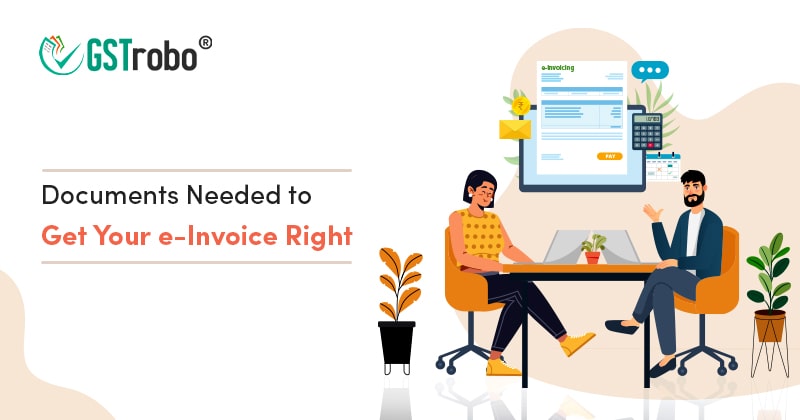Documents Needed to Get Your E-invoice Right!
The GST Council agreed at its 35th meeting to implement an e-invoicing method that would apply to specific groups of people. ‘E-invoicing,’ also known as ‘electronic invoicing,’ is a method by which GSTN authenticates B2B invoices for online use on the popular GST platform. The GST Network’s Invoice Registration Portal would assign an ID number to each invoice under the new digital invoicing method. This system will send all invoice details in real-time to both the GST portal and the e-way bill system. This would also eliminate the need for manual data entry during the submission of GST returns and even the generation of Part-A e-way bills because the information is explicitly transferred by the IRP to the GST portal.

According to Rule 48(4) of the CGST Rules, notified classes of registered persons must prepare invoices by uploading specified invoice particulars (in FORM GST INV-01) to the Invoice Registration Portal (IRP) and obtaining an Invoice Reference Number (IRN). Following the ‘e-invoicing’ process outlined above, the invoice copy containing, among other things, the IRN (with QR Code) issued by the notified supplier to the buyer is commonly referred to as a ‘e-invoice’ in GST. Because of the standard e-invoice schema (INV-01), ‘e-invoicing’ facilitates the electronic exchange of the invoice document (structured invoice data) between a supplier and a buyer.
How can you create a GST e-invoice?
The taxpayer’s system generates an invoice, which is then sent to the Invoice Registration Portal (IRP) for approval. Following authorization, the invoice data is updated with IRP’s digital signature, QR Code, and Invoice Registration Number (IRN). This is known as an E-Invoice. The current system is comparable to e-invoicing. Individuals who have registered will continue to issue GST invoices through their own accounting/billing/ERP systems. These invoices are now routed to the ‘Invoice Registration Portal,’ which assigns each e-invoice a unique ‘Invoice Reference Number’ after digitally signing it and adding a QR Code. After that, the invoice can be sent to the recipient. A GST invoice is only valid if it is accompanied by a valid IRN.
What information is required to generate an e-invoice?
The data points required to generate an e-invoice are determined by the e-invoice schema and template. Details such as buyer and supplier information, invoice value, tax rate, description and HSN of goods or services, taxable value, and tax amounts are all required. Payment-related optional data fields include bank account number, mode of payment, pre-tax values, reference document number, and so on.
The number of line items allowed per e-invoice is limited to 1000. If no value is to be entered into any of the mandatory fields, a ‘Nil’ value should be entered for that field to ensure successful IRN generation.
What types of documents must be reported to the GST System as part of E-Invoicing?
A list of documents must be gathered and uploaded to the portal in order to generate an E-invoice. Taxpayers must submit the following documents to the e-invoice system.
- Supplier’s Invoice
- Supplier’s Credit Note
- Supplier’s Debit Note
Information that is required to be filled for an E-invoice
An e-Invoice contains transaction details and information, including the supplier and recipient’s information. Aside from the information provided by both parties, an e-Invoice includes a number of Mandatory and Optional Fields. The portal makes certain that no gaps are left unfilled.
The necessary details are organised into five major sections:
- Basic details
- Supplier’s information
- Recipient’s information
- Invoice item details
- Document total
Furthermore, there are two main Annexures:
- Invoice Item Details
- Document Total Details
The list of information that is to filled to generate an E-invoice is mentioned below:
- Document Type Code
- GSTIN of the supplier
- Legal name of the supplier
- Supplier’s location Supplier’s address
- Pincode of the Supplier
- Supplier’s state code
- The document’s date
- Number of the document
- The recipient’s legal name
- State code of the recipient
- The recipient’s address
- The supply location’s pincode
- The supply location’s state code
- Location of the recipient
- The recipient’s state code
- The recipient’s GSTIN
- Provide an item description
- Code for supply type
- Dispatch from name, address, and ZIP code
- Item price IGST value, CGST value, SGST value
- Rate of GST
- HSN number
- Total invoice amount
Conclusion
As a result, the documents and information that will serve as the foundation for and complete the process of generating E-invoices are detailed above. The clerical part of documentation and information filling may appear complex and difficult, but it can be done very easily with automation, GST-enabled software and tools.
GST E-invoicing by GSTrobo includes all of the features that you would expect from an E-invoicing software. It includes detailed knowledge of the subject and works with working customary knowledge of its compliance. You can start using it for free and see for yourself that E-invoicing isn’t all that difficult.
